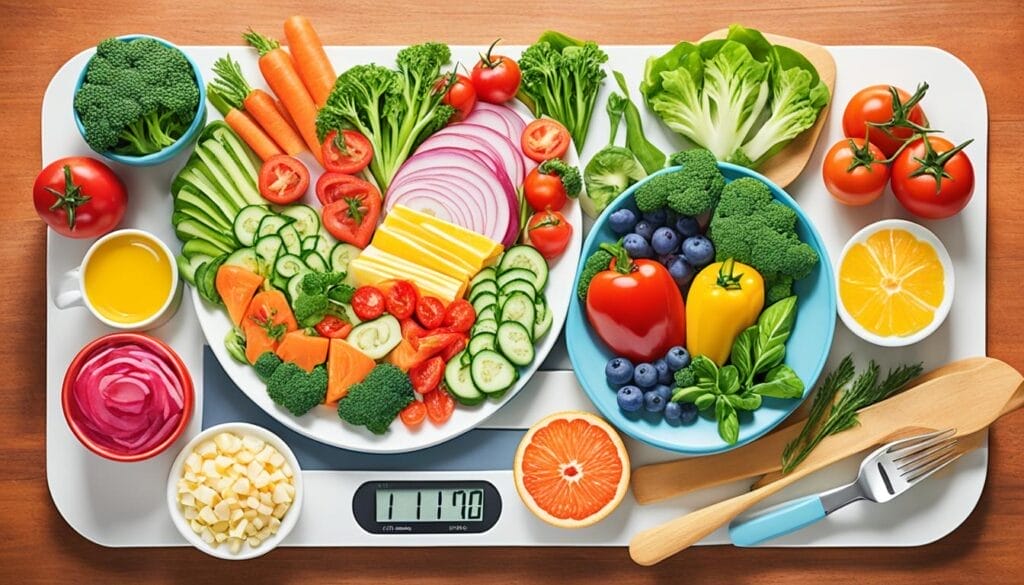Have you ever looked in the mirror and felt disappointed with what you see? I know I have tried many diets and tips but ended up feeling frustrated. Losing weight for good can be tough.
But, the good news is that it can get better with some calorie deficit strategies that really work.
After some time, I found the secret to losing weight and keeping it off. It’s all about eating fewer calories than you burn, creating a calorie deficit. This way, I managed to lose weight and boost my self-esteem.
But don’t get me wrong – it’s not about starving yourself or following quick-fix diets. It’s about making wise food choices and eating healthily. It’s about what suits you best and making these changes part of your life.
Key Takeaways:
- Creating a calorie deficit is the foundation for sustainable weight loss.
- Focus on nutrient-rich foods and maintain a balanced diet.
- Incorporate regular exercise to increase calorie expenditure.
- Consider individual factors such as basal metabolic rate and lifestyle when creating a calorie deficit.
- Consult healthcare professionals or registered dietitians for personalized guidance and support.
Understanding Calorie Deficit and Weight Loss
A calorie deficit means you eat fewer calories than your body uses. This leads your body to burn stored fat for energy. It’s a key part of losing weight.
Losing 1 pound requires burning about 3,500 more calories than you eat. You can do this by creating a deficit of 500-1,000 calories each day.
This deficit often requires a mix of eating less and moving more. You reduce calories by eating mindfully and raise the calories you burn through exercises. This makes weight loss easier.
The Role of Energy Balance in Weight Loss
Energy balance is vital for managing your weight. Being in a deficit forces your body to use its fat stores. This is how you lose weight.
Weight loss strategies should fit what works best for you. For some, it’s cutting down on food, for others, it’s being more active. Both reduce calories, aiding weight loss.
“Calorie deficit strategies are essential for achieving sustainable weight loss. It’s all about finding the right balance between calorie intake and calorie expenditure.”
However, creating a deficit isn’t about extreme diets or overworking out. A steady, realistic plan is best for keeping the weight off long-term.
Weight loss strategies should lead you to eat nutrient-rich foods that are filling and keep portions in check. Eating a mix of fruits, vegetables, proteins, grains, and fats helps balance your diet while maintaining a deficit.
| Calorie Deficit | Weight Loss Strategies | Energy Balance |
|---|---|---|
| Occurs when calorie intake is lower than calorie expenditure. | Combining diet and exercise to create a calorie deficit. | The relationship between calorie intake and calorie expenditure. |
| Triggers the body to use stored fat for energy. | Customised approaches based on individual goals and preferences. | Key for weight management and achieving sustainable weight loss. |
| Creating a calorie deficit of 500-1,000 calories per day can lead to 1-2 pounds of weight loss per week. | Mindful eating, portion control, and regular physical activity. | Achieving balance is crucial for long-term success. |
Using a calorie deficit wisely can bring lasting weight loss. Understanding how it works, eating well, and enjoying exercise are crucial. They help meet your weight goals and make you healthier overall.
Creating a Calorie Deficit Through Diet
Doing well in weight loss means eating less calories than you use each day. Eating foods that are packed with nutrients but not many calories helps your body burn fat. This leads to losing weight in a way that sticks.
It’s smart to fill your plate with lots of fruit, greens, clean meats, and whole grains. These choices are rich in all the good stuff but not in calories. So, go for lots of bright fruits and greens, pick lean meats like chicken or fish, and choose whole grains like brown rice.
Avoiding soft drinks and going for water or drinks without added sugar is a big win. Sweet drinks pile on the calories with no health boost. Drinking enough water keeps you from feeling too hungry and helps your body run smoothly.
Planning what you’ll eat ahead of time is also a great move. It makes sure your meals are just right for you. This helps keep your portion sizes sensible and stops you from acting on sudden cravings.
Don’t forget about foods that kick up your metabolism. Things like green tea, hot peppers, and foods rich in protein can help you burn more calories without extra effort. They get your body working more efficiently.

Metabolism-Boosting Foods
| Food | Metabolism-Boosting Effect |
|---|---|
| Green tea | Contains catechins that accelerate metabolism |
| Chili peppers | Capsaicin in peppers increases metabolic rate |
| High-protein sources (chicken, fish, tofu) | Protein requires more energy to digest, boosting metabolism |
Using these tips in your daily eating can really help you eat fewer calories. Stick to foods that pack a lot of nutrition, keep hydrated, and plan your meals for success. Also, go for foods that boost your metabolism to help with losing weight.
Increasing Calorie Expenditure with Exercise
Exercise is key to losing weight by creating a calorie deficit. This is done through a mix of cardio and strength training. It raises your calorie use and boosts fat burning. We’ll look at exercises that help you lose more calories.
The Benefits of Cardiovascular Exercise
Cardio workouts are great for burning calories and making your heart healthier. Walking, jogging, cycling, and swimming are perfect. They up your heart rate and burn a lot of energy. Plus, they fit any daily schedule and meet different fitness levels.
| Cardiovascular Exercise | Calories Burned (per 30 minutes)* |
|---|---|
| Walking | 120-180 |
| Jogging | 240-300 |
| Cycling | 210-315 |
| Swimming | 180-360 |
*Calories burned may change depending on weight and how hard you exercise.
The Power of Resistance Training
Strength training helps build more muscle. This makes your metabolism faster. With more muscle, you burn extra calories, even when chillaxing. Include weightlifting, bodyweight exercises, and resistance band workouts to burn more calories long-term.
Designing an Effective Workout Plan
Mix cardio and resistance exercises for the best weight loss results. Do about 150 minutes of moderate cardio every week. For strength, train 2-3 times within that week. Always pick exercises you like. This helps you stay consistent and keeps off the weight.
Always feel out your body and push slowly to get in better shape. A fitness pro can help craft your perfect workout plan. With commitment and the right exercises, you can win at weight loss.
Factors to Consider for a Sustainable Calorie Deficit
When looking to lose weight for the long term, remember these factors. They’re key in making a calorie deficit work well. Knowing them will guide your choices. It’ll also help in picking up healthy eating and lifestyle changes for lasting weight loss and feeling good.
Basal Metabolic Rate (BMR)
Your basal metabolic rate (BMR) is the energy you use when at rest. Knowing your BMR helps set your calorie goals. You can find your BMR online by inputting your age, sex, weight, and height. Having this number, you can tailor your diet to lose weight safely.
Thermic Effect of Food
The thermic effect of food is the calories used to digest meals. Some foods need more energy to digest. Lean proteins and fibrous vegetables fall into this category. Adding these to your diet can help burn more calories, supporting your weight loss journey.
Lifestyle Changes
Creating healthy eating habits and changing your lifestyle is important for long-term weight loss. Skip harsh diets and quick fixes. Focus on eating more nutritious foods every day. Including a variety of fruits, veggies, grains, and proteins is a good start. Also, don’t forget to be active, manage stress, and get enough sleep. These habits will help you maintain your weight loss over time.
“Sustainable weight loss is a result of healthy eating habits and positive lifestyle changes.”
Understanding your BMR, the thermic effect of food, and lifestyle changes is key to an effective calorie deficit. Sustainable weight loss is about balance, not extreme methods. It’s adopting a sound diet and lifestyle that you can keep up for the long haul.

| Factors to Consider | Explanation |
|---|---|
| Basal Metabolic Rate (BMR) | The number of calories your body needs to maintain basic functions at rest. Understanding your BMR helps determine your daily calorie needs. |
| Thermic Effect of Food | The energy expended during the digestion, absorption, and metabolism of nutrients. Incorporating foods with a high thermic effect aids in calorie burning. |
| Lifestyle Changes | Making long-term healthy eating habits and lifestyle changes supports sustainable weight loss. |
Different Approaches to our Calorie Deficit Strategies
To create a calorie deficit, there are several ways. These include intermittent fasting, low-carb diets, and low-fat eating plans. Each method brings its own special benefits and things to keep in mind. The best choice for you depends on what you like and want to achieve.
Intermittent Fasting
Intermittent fasting is a trendy way to cut calories. It means eating and then stopping for a while. You can try the 16/8 method or the 5:2 plan. They involve eating in cycles or days. Intermittent fasting is a good trick to eat less and lose weight.
Low-Carbohydrate Diet
Eating fewer carbs is another way to make a calorie deficit. This means fewer bread, pasta, and sweet snacks. When you cut carbs, your body uses its fat stores for fuel. This way, you shed some pounds. It also helps balance your blood sugar and boost your metabolism.
Low-Fat Diet
Lowering your fat intake is also effective for losing weight. You’d avoid high-fat foods like cooking oil and fatty meats. Instead, focus on foods low in fat but rich in nutrients. Think vegetables, fruits, and lean meats. Doing so helps keep your calories down and improves your health.
Remember, what works for one person may not for another. And it’s okay to ask for advice. Talking to a professional, like a dietitian, is a smart move. They can tailor a plan that suits you and your goals.

To Sum Up...
Making a calorie deficit is key for losing weight long term. You can do this through good eating, staying active, and changing your lifestyle. This way, you hit your weight goals and keep healthy.
Eating the right foods is a big part of your weight loss journey. Look for foods full of nutrients like fruits, veggies, lean meats, and whole grains. This helps you get all the vitamins, minerals, and antioxidants you need. It also keeps your eating balanced.
Working out often is just as crucial. Find exercises you love like walking, jogging, swimming, or biking. This will burn more calories. Add strength training too. It helps you create more muscles, speed up your metabolism, and burn more fat.
Always remember, losing weight in a healthy way takes time and effort. It’s good to talk to a doctor or a dietitian for advice. They can offer you a plan that fits you. With the right mix of eating well, staying active, and keeping at it, you’ll meet your weight goal. And you’ll continue to lead a healthy life for the future.
FAQ
What is a calorie deficit?
A calorie deficit happens when you consume fewer calories than you use up. This makes your body burn fat to get the energy it needs. So, you start losing weight.
How can I create a calorie deficit?
To make a calorie deficit, you can eat fewer calories or exercise more. Or do both. This means using up more calories than you eat, and it’s done through a mix of eating less and moving more.
What should I eat to create a calorie deficit?
Aim for foods that are packed with nutrients but not many calories. This includes lots of fruits, veggies, lean meats, and whole grains. Ditch the sugary drinks for water or unsweetened options. Planning your meals can help you eat the right amount.
How can exercise help create a calorie deficit?
Working out plays a key role in a calorie deficit. Activities like walking, running, or biking burn calories. Plus, lifting weights can increase your muscle. With more muscle, your body uses more calories even when you’re not working out.
What factors should I consider for a sustainable calorie deficit?
Think about your basal metabolic rate (BMR), the thermic effect of food, and how much energy you use. Knowing your BMR helps you figure out how many calories you need daily. Choosing food that’s good for burning calories, like proteins and veggies, is also handy. And remember, for long-lasting effects, focus on healthy eating and lifestyle changes.
What are different approaches to creating a calorie deficit?
You can try different calorie deficit strategies, such as intermittent fasting or changing your diet to have fewer carbs or fats. The best choice depends on what works for you and your health goals.
How can I achieve sustainable weight loss with calorie deficit strategies?
The key to lasting weight loss is combining good nutrition with regular exercise. By eating healthily, staying active, and changing your lifestyle, you can hit your weight loss target and keep a healthy life.
Source Links
Share Me:
READY TO UNLEASH
YOUR BEST SELF?
Click “Sign Me Up!” And Start Your Fitness Transformation!





